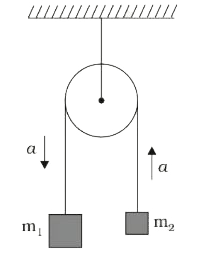Two bodies of masses M and m are allowed to fall from the same height . If air resistance for each body be same , will the two bodies reach the ground simultaneously ?
Let R be air resistance
For 1st body Ma1=Mg−R
a1=Mg−RM=g−RM
For 22d body ma2=mg−R
a2=mg−Rm=g−Rm
As M>m
∴a1>a2
Thus, heavier body will reaach ground first.
Topper's Solved these Questions
- MOTION IN A PLANE BOOK - MODERN PUBLICATIONCHAPTER - MOTION IN A PLANE EXERCISE - Revision Exercises (Long Answer Question)
6 Videos
- MOTION IN A PLANE BOOK - MODERN PUBLICATIONCHAPTER - MOTION IN A PLANE EXERCISE - Revision Exercises (Numerical Problems)
26 Videos
- MOTION IN A PLANE BOOK - MODERN PUBLICATIONCHAPTER - MOTION IN A PLANE EXERCISE - Revision Exercises (Fill in the Blanks)
9 Videos
- MECHANICAL PROPERTIES OF FLUIDSBOOK - MODERN PUBLICATIONCHAPTER - MECHANICAL PROPERTIES OF FLUIDSEXERCISE - Chapter Practise Test
16 Videos
- MOTION IN A STRAIGHT LINE BOOK - MODERN PUBLICATIONCHAPTER - MOTION IN A STRAIGHT LINE EXERCISE - CHAPTER PRACTICE TEST
16 Videos
Similar Questions
i) If the net force acting on a body is zero, will it remain necessarily at rest?
(ii) Two bodies of mass M and m are allowed to fall from the same height. If air resistance for each body be same, will the two bodies reach the ground simultaneously?
View SolutionTwo bodies of masses m1andm2(<m1) are connected to the ends of a massless cord and allowed to move as shown in figure. The pulley is both massless and frictionless. The acceleration of the centre of mass is (m1−m2)n(m1+m2)2g. Find the value of n.

View Solution
Knowledge Check
Assertion: Two bodies of masses M and m(M>m) are allowed to fall from the same height if the air resistance for each be the same then both the bodies will reach the earth simultaneously.
Reason: For same air resistance, acceleration of both the bodies will be same.AStatement-1 is True , Statement-2 is True, Statement-2 is a correct explanation for Statement-1.BStatement-1 is True , Statement-2 is True, Statement-2 is NOT a correct explanation for Statement-1.CStatement-1 is True, Statement-2 is FalseDStatement-1 is False, Statement-2 is True.Assertion: Two bodies of masses M and m(M>m) are allowed to fall from the same height if the air resistance for each be the same then both the bodies will reach the earth simultaneously.
Reason: For same air resistance, acceleration of both the bodies will be same.AIf both assertion and reason are true and reason is the correct explanation of assertion.BIf both assertion and reason are true but reason is not the correct explanation of assertion.CIf assertion is true but reason is false.DIf both assertion and reason are false.Assertion : Two bodies of unequal masses m1andm2 are dropped from the same height. If the resistance offered by air to the motion of both bodies is the same, the bodies will reach the earth at the same time.
Reason : For equal air resistance, acceleration of fall of masses m1andm2 will be different.AIf the both Assertion and Reason are true and the Reason is correct explanation of the Assertion.BIf both Assertion and Reason are true but Reason is not the correct explanation of Assertion.CIf Assertion is true, but the Reason is false.DIf Assertion is false but the Reason is true.
Two spherical bobs, one metallic and other of glass, of the same size are allowed to fall freely from the same height above the ground. Which of the two would reach the ground earlier and why ?
View SolutionTwo bodies of masses 4kg and 6kg are thrown with the same velocity in the same direction . Which body will reach the ground first ?
View SolutionA body falls from a height 'h'. In absence of air resistance time of descent of body is
View SolutionTwo bodies have same mass and speed, then
View SolutionTwo bodies of different masses are dropped simultaneously from the top of a tower. If air resistance is proportional to the mass of the body then,
View Solution
